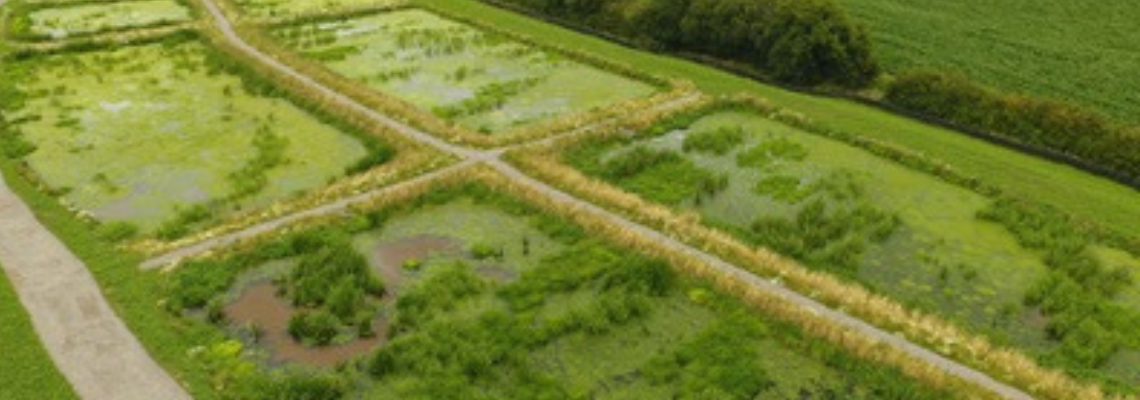Wessex Water has trialled a first-of-its-kind wastewater treatment method to remove phosphorus from sewage effluent using wetlands.
Tapping into a natural solution
Wetlands are often called 'nature's kidneys' due their ability to remove sediment and pollutants from water, reducing the number of harmful substances entering waterways.
One utility in South West England has turned to Integrated Constructed Wetlands (ICW) as a sustainable method of managing and treating wastewater discharge.
Wessex Water has now completed a wetland trial as a natural wastewater treatment method for removing phosphorus from sewage effluent.
“Nature-based solutions are being considered by water companies for engineering projects.”
In 2020, the utility began operating a 0.8-hectare wetland at its Cromhall Water Recycling Centre in South Gloucestershire.
The trial looked at how effectively the wetland removed nutrients, organic pollutants and chemicals and delivered biodiversity enhancement following its construction.
“Nature-based solutions are being considered by water companies for engineering projects and this shift in regulatory emphasis should encourage their wider adoption,” the utility said in the results report.
“However, there are a relatively small number of nature-based solutions and a paucity of data on their performance and benefits to inform their uptake.”
The trial process
The site treats wastewater from population equivalent of over 2000, with a mean daily discharge of 1.4 million litres (ML)/day. Current treatment comprises mechanical screening, a single oxidation ditch and a settlement tank, with effluent discharged to the Tortworth Brook.
The wetland comprises 12 modular cells combining open water, surface flow marsh and wet grassland habitat types, designed to perform ecological and biochemical functions.
After the first four cells, Wessex water said the flow is split into parallel, mirrored treatment streams before combining prior to discharge to the brook.
The ICW was designed to accept a maximum hydraulic loading rate of 32 l/s (2800 m3/day) with a hydraulic residence time of 0.4 to 3.2 days, depending on the flow rate.
Operational at the end of April 2020, the wetland was monitored for a limited period of operation to the end of November 2021.
“In total, the ICW saw a 27.5 per cent reduction in total phosphorus.”
Wessex found that the effectiveness of the wetland appeared to be at its greatest during the summer, with lower water flows, warmer temperatures, more daylight and significant macrophyte growth.
On average, annually the wetland reduced concentrations of phosphorus to within the proposed permit limit of three milligrams of phosphorus per litre at Cromhall Water Recycling Centre.
In total, the ICW saw a 27.5 per cent reduction in total phosphorus as well as a 62 per cent reduction in ammonia and more than 60 per cent reduction in nitrogen. The ICW also led to a 111 per cent increase in biodiversity value.
Accepting varying performance
The wetlands results are overall positive but there remains must to study in the use of wetlands for phosphorus removal.
Sampling conducted by the EU Water Framework Directive found that the water quality status of the furthest downstream sampling point on the Tortworth Brook improved from indicative Bad to Poor - which is a step in the right direction.
Furthermore, while the ICW shows potential its one main drawback could be its fluctuating efficiency.
“There needs to be an acceptance that the performance will vary due to the natural processes involved.”
The report for Wessex Water concluded: “To allow nature-based solutions such as Cromhall Integrated Construction Wetland to become viable alternatives to ‘traditional’ treatment approaches, there needs to be an acceptance that the performance will vary due to the natural processes involved.’’
Elsewhere, natural alternatives to traditional wastewater treatment are being trialled.
In Scotland, Utility Scottish Water demonstrated a project using water fleas, earthworms and microalgae as a carbon-neutral alternative method of treating wastewater.
Furthermore, water and engineering companies such as Stantec are already using biomimicry in their models.
Related content
- Arthur Umble: unlocking water resources using biomimicry
- Worms and water fleas: "innovative wastewater treatment" demonstrated in Scotland
- 5 cities & 18 solutions kick-start digital water city initiative







